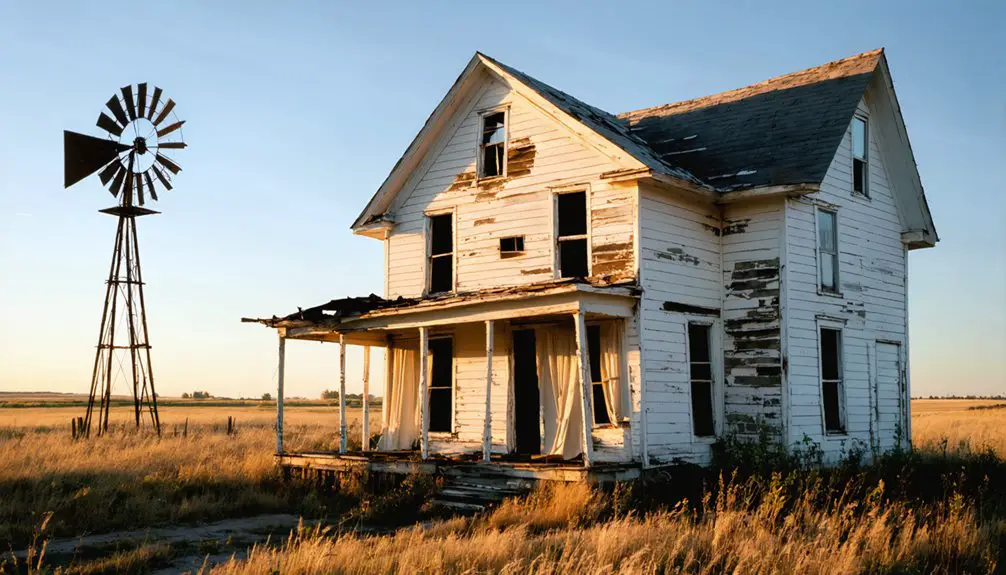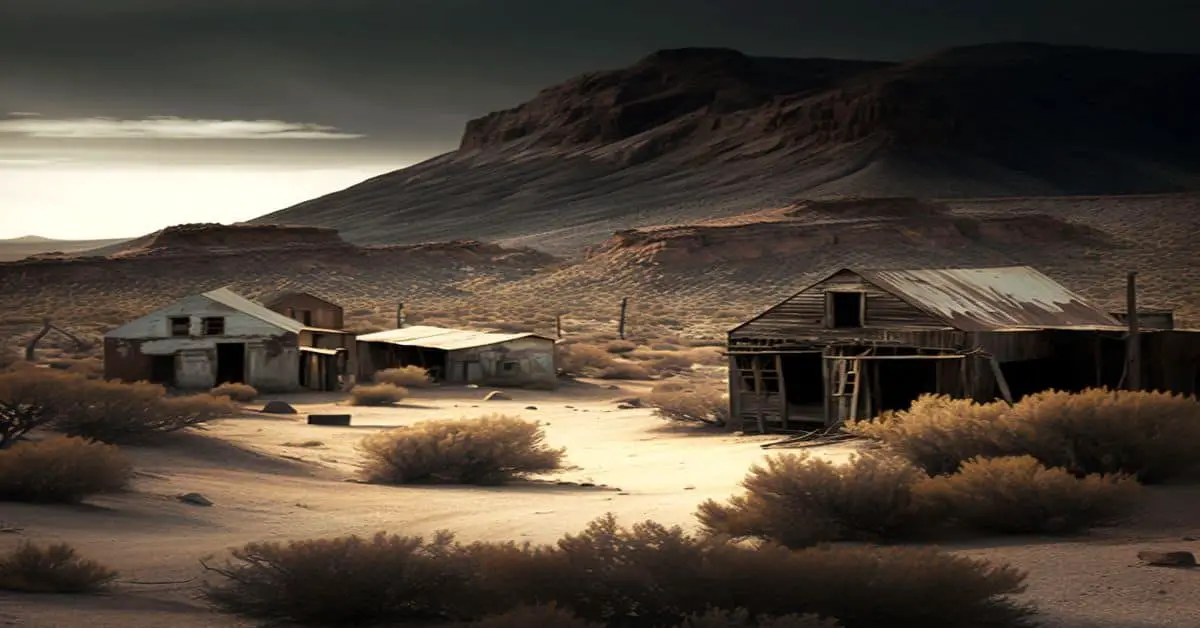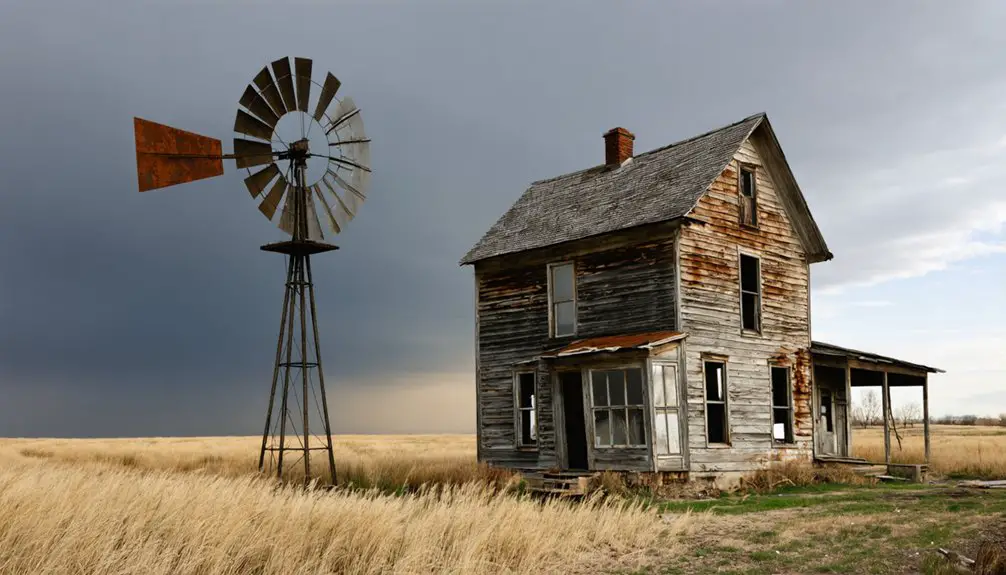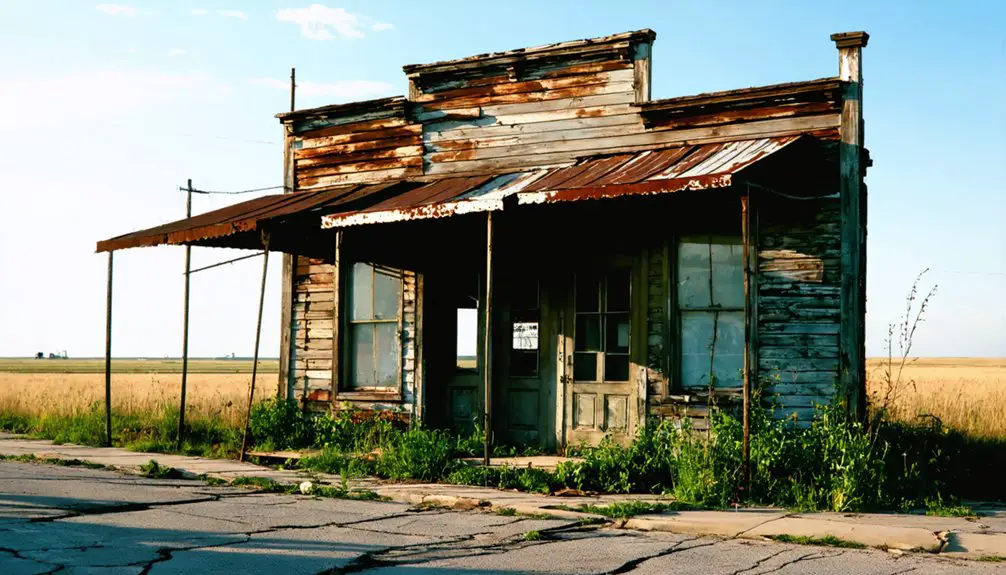You’ll find New Home’s remnants along Nebraska’s Missouri River, where it flourished as a frontier trading post in the 1820s. After establishing three major trading centers, the settlement grew to 373 residents by 1930. But prairie fires, floods, and the Great Depression devastated the community. Its population dwindled to 98 by 2000, leaving weathered foundations and abandoned storefronts as silent witnesses to its frontier past. These historical ruins tell a compelling story of boom-and-bust pioneer life.
Key Takeaways
- New Home began as a thriving frontier settlement anchored by three major trading posts in the 1820s along Nebraska’s Missouri River.
- The town experienced severe economic challenges from prairie fires, floods, and the financial panic of the late 1800s.
- Population peaked at 373 residents in 1930 before declining sharply due to the Great Depression and reduced railroad activity.
- By 2000, the population had dwindled to just 98 residents as businesses closed and younger people left for opportunities elsewhere.
- The closure of the post office marked New Home’s transformation into a ghost town, leaving only weathered foundations and abandoned structures.
The Rise of a Frontier Settlement
As Nebraska’s frontier expanded in the mid-19th century, settlements initially emerged along the Missouri River as ambitious but underdeveloped “paper towns.” One such settlement, Oreapolis near present-day Plattsmouth, exemplified the speculative nature of 1850s town development in Nebraska Territory.
You’ll find that settlement patterns largely depended on anticipated railroad routes and county seat designations. Towns sprouted up with essential frontier businesses – blacksmiths, hotels, stores, and schools – as pioneers sought to establish structured communities. Many towns, like Sarpy Center, included a blacksmith, hotel, store, school, and even a newspaper to serve their residents. The Amboy Mill became a vital economic center for its community until the 1940s.
Cultural identity often took root through ethnic settlements, like Dannevirke’s Danish community in 1874. However, these frontier towns faced significant challenges, including unstable banking systems and the economic panic of 1857.
A town’s survival hinged on securing railroad access and maintaining political importance as a regional hub.
Life Along the Missouri River
Life along the Missouri River shaped Nebraska’s early settlement patterns through a complex web of Native American relations, pioneer challenges, and economic opportunities. You’d find the Omaha and Otoe tribes maintaining peaceful interactions with settlers, as demonstrated by Chief Big Elk’s welcoming stance toward Mormon pioneers.
If you’d settled here in the 1840s-50s, you’d have faced harsh conditions while benefiting from strategic advantages. The river bluffs provided water access and grazing land for your herds, while the Missouri River served as your lifeline for trade and transportation. A community of nearly 3,500 pioneers settled in log cabins and sod houses by late 1846.
Your agricultural practices would’ve thrived on the rich prairie soil, and you’d have relied on river towns to connect with national markets. The economic panic of 1857 forced many settlers to shift their focus from land speculation to farming for survival. Despite the challenges of disease outbreaks and frontier conditions, the river’s presence made settlement viable through established trade routes and fertile farmland.
A Thriving Trading Post Community
Three major trading posts anchored New Home’s early commercial development in the 1820s, with Cabanné’s Trading Post and Fontenelle’s Post emerging as the most prominent.
These bustling centers of cultural exchange connected European-American traders with Omaha, Otoe, Pawnee, and Missouri tribes. The American Fur Company established the first trading post in the area in 1822.
You’ll find that each trading post included:
- Large warehouses storing furs and trade goods
- Blacksmith shops crafting metal tools
- Living quarters for traders and agents
- Meeting spaces for negotiations with tribal leaders
The posts weren’t just commercial hubs – they shaped the region’s development. Joshua Pilcher built the first European-American settlement in Nebraska on the west bank of the Missouri River.
As fur trade declined, they evolved into Indian agencies and supply points for westward emigrants.
Eventually, some posts transformed into permanent settlements, laying the foundation for Nebraska’s territorial expansion and the growth of communities like Bellevue.
Natural Disasters and Economic Challenges
You’ll find that New Home’s downfall began with a series of devastating prairie fires that swept through the region, destroying essential businesses and homesteads.
The town’s struggles intensified during the financial panic of the late 1800s, which dried up investment and forced many merchants to close their shops.
Like other ghost town communities in Nebraska, recurring flood damage along nearby creeks further discouraged rebuilding efforts, ultimately accelerating the community’s decline into abandonment. Many settlements faced similar fates, as towns located near creek areas were particularly vulnerable to destructive flooding.
Devastating Prairie Fires
Since the early 1900s, devastating prairie fires have shaped Nebraska’s landscape, with both natural and human causes driving these destructive events. The prairie fire frequency averaged every 4-5 years, creating significant ecological impact across the region’s grasslands.
You’ll find these fires were particularly intense during historic drought years, including:
- Immediate 26% vegetation loss after lightning strikes
- Severe wind erosion in sandy soils following spring burns
- Up to 75% destruction of upper canopy in mixedgrass prairies
- Extensive damage during “Indian summer” in October-November
Native Americans used controlled burns for hunting, while early settlers started fires to manage cropland and reduce hazards near their homes. Dense smoke plumes from these fires often obscured sunlight for extended periods.
Today, you’ll see ranchers using prescribed burns to fight eastern redcedar invasion and restore valuable grazing lands, continuing the region’s long relationship with fire.
Financial Panic Effects
Throughout the late 1800s, devastating financial panics struck Nebraska’s emerging frontier towns, with the Panics of 1857 and 1893 delivering particularly severe blows to New Home’s survival prospects.
The region’s financial instability manifested through widespread bank failures, which wiped out settlers’ life savings and eliminated essential access to credit. Property values plummeted as speculation-driven real estate bubbles burst. The nationwide Financial Panic of 1857 triggered a catastrophic collapse of railroad stocks, halting land development across Nebraska.
Investment failures cascaded through the community as unemployment soared to nearly 20% during the 1893 crisis. You’d have witnessed the exodus of desperate residents abandoning their mortgaged homes and businesses.
The collapse of railroad companies further isolated New Home, cutting off crucial economic lifelines. Without stable banks or reliable transportation networks, the town’s commerce ground to a halt, accelerating its transformation into a ghost town.
Flood Damage Impact
Natural disasters dealt devastating blows to New Home’s survival, with catastrophic floods leading the assault on the struggling frontier town.
Like many Nebraska settlements, New Home faced nature’s fury through devastating flood cycles that eroded both land and hope.
You’ll find the town’s flood recovery efforts were overwhelmed by recurring disasters that tested community resilience beyond its limits.
Consider these haunting scenes from Nebraska’s flood history:
- Raging waters tearing away essential bridges and roads, isolating rural families
- Farmlands transformed into muddy lakes, destroying crop yields and livelihoods
- Homes and barns swept away by surging rivers, forcing families to abandon generations of work
- Critical infrastructure crumbling under repeated flood assaults, making repairs increasingly futile
These relentless floods ultimately contributed to New Home’s transformation into a ghost town, as residents gradually sought safer ground elsewhere.
The Final Days of New Home
You’ll notice New Home’s final decline accelerated after its peak population of 373 in 1930, as the Great Depression and reduced railroad activity dealt devastating blows to the local economy.
By the latter half of the 20th century, businesses along the main street had shuttered their doors while residents steadily moved away in search of better opportunities.
The town’s transformation into a ghost town became complete as its population dwindled to just 98 residents by 2000, leaving behind abandoned storefronts and empty buildings as silent testimonies to its former liveliness.
Economic Collapse Hits Hard
As economic turmoil gripped Nebraska during the Panic of 1857, New Home’s fragile economy crumbled under the weight of railroad bankruptcies and collapsing land values.
The economic decline swept through the community like a prairie fire, leaving devastation in its wake. Despite initial community resilience, the town couldn’t withstand the mounting pressures.
You would’ve witnessed these devastating changes unfold:
- Railroad construction halted abruptly, leaving promised transport links unfinished.
- Local banks failed as wildcat speculation schemes collapsed.
- Property values plummeted, leaving landowners with worthless investments.
- Businesses shuttered their doors as residents fled in search of opportunities.
Without reliable transportation or financial stability, New Home’s fate was sealed.
The exodus of workers and families accelerated as employment dried up, transforming a once-promising settlement into another Nebraska ghost town.
Population Steadily Drifts Away
The economic collapse of New Home triggered a steady stream of departures that would define the town’s final chapter.
You’d see familiar faces vanish as younger residents left for jobs and education in bigger cities, mirroring rural depopulation trends across Nebraska. Those who stayed watched their neighbors’ homes empty one by one, while local services and businesses shuttered their doors.
As population trends continued downward, you’d find the remaining residents taking on multiple civic roles just to keep basic functions alive.
Unlike some Nebraska towns that found new life through immigrant populations, New Home couldn’t attract fresh faces. The aging community dwindled further as time passed, with each departure making it harder for others to stay.
The town’s social fabric slowly unraveled, leaving only echoes of its former liveliness.
Ghost Town Status Emerges
While businesses had already begun shuttering their doors, the closure of New Home’s post office in the early 1900s marked a decisive turning point toward ghost town status.
As essential services vanished and infrastructure crumbled, you’d have witnessed the town’s stark transformation into a hauntingly empty landscape.
Today, New Home’s historical significance lives on through:
- Weathered foundations peeking through overgrown prairie grass
- Crumbling walls that once housed vibrant businesses and family homes
- Abandoned railroad tracks that once connected the town to crucial trade routes
- Silent ruins that spark ghost stories among curious visitors
Nature steadily reclaimed the town as families drifted away seeking better opportunities.
What remains serves as a poignant reminder of how quickly a thriving community can fade into Nebraska’s vast plains.
Exploring the Ghost Town Today
Modern-day visitors to New Home, Nebraska will find limited physical remnants of this once-hopeful frontier settlement. Your ghost town exploration might reveal old foundations, abandoned roadbeds, and scattered ruins typical of Nebraska’s forgotten communities.
You’ll need to navigate rural roads carefully, as infrastructure has degraded over time. When visiting this historically significant site, you’ll want to prepare for minimal amenities and limited cell service.
You’re free to hike the area and photograph any remaining structures, but remember to respect private property boundaries, as many ghost town sites overlap with active farmland. For the best experience, bring detailed maps and research materials from local historical societies to understand New Home’s layout and former points of interest.
Frequently Asked Questions
Were There Any Notable Crimes or Lawlessness in New Home’s History?
You won’t find significant crime records or notable lawlessness in the town’s history. Local law enforcement was minimal, but historical documents suggest the small community maintained order through self-policing practices.
What Native American Tribes Originally Inhabited the New Home Area?
Peaceful Pawnee peoples primarily populated these plains first, marking the area’s tribal heritage. Later, you’d find Lakota Sioux moving through, bringing their nomadic buffalo-hunting culture of deep cultural significance.
Did Any Famous Pioneers or Historical Figures Visit New Home?
You won’t find records of famous visitors or notable pioneers stopping at New Home. While Nebraska’s pioneer legacy is rich with historical figures, there’s no documented evidence of prominent personalities visiting this settlement.
What Happened to the Cemetery and Burial Grounds of New Home?
You’ll find the cemetery’s burial grounds still exist but lie hidden beneath thick vegetation. Despite minimal preservation efforts, some plots remain identifiable, including pioneer graves marked by perennial irises and weathered tombstones.
Were There Any Documented Paranormal Activities at the New Home Site?
You won’t find documented ghost sightings or haunted locations at this site. Unlike other Nebraska paranormal hotspots with verified activity, there’s no official record of supernatural events occurring here.
References
- https://www.nebraskalife.com/blog/post/saint-deroin-ghost-town
- https://www.onlyinyourstate.com/experiences/nebraska/ghost-town-cemetery-ne
- https://visitnebraska.com/trip-idea/explore-7-authentic-ghost-towns-nebraska
- https://history.nebraska.gov/oreapolis-nebraskas-ghost-town/
- https://www.youtube.com/watch?v=redtU6GT-BY
- https://nebraskarules.tripod.com/id11.html
- https://www.youtube.com/watch?v=q1Bww945Vhc
- https://travelnebraska.org/nebraska-history/river-settlements-in-nebraska
- https://history.nebraska.gov/wp-content/uploads/2017/12/doc_publications_NH1961MissouriRFrontier.pdf
- https://www.britannica.com/place/Nebraska-state/History



